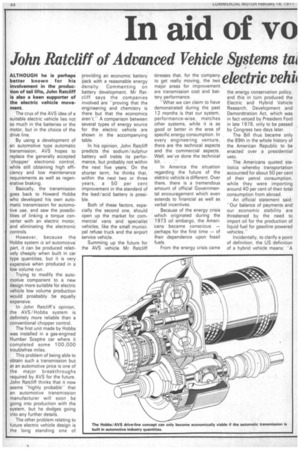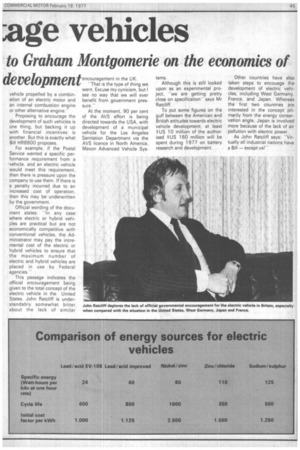In aid of vo :age vehicles
Page 46

Page 47

If you've noticed an error in this article please click here to report it so we can fix it.
John Ratcliff of Advanced Vehicle Systems tai to Graham Montgomene on the economics of
ALTHOUGH he is perhaps better known for his involvement in the produc tion of tail lifts, John Ratcliff is also a keen supporter of the electric vehicle movement.
The crux of the AVS idea of a suitable electric vehicle lies not so much in the batteries or the motor, but in the choice of the drive line.
By using a development of an automotive type automatic transmission, AVS hopes to replace the generally accepted 'chopper electronic control, while still obtaining high efficiency and low maintenance requirements as well as regenerative braking.
Basically, the transmission goes back to Howard Hobbs who developed his own auto matic transmission for automotive use, and saw the possibi lities of linking a torque converter with an electric motor, and eliminating the electronic controls.
However, because the Hobbs system is anautomotive
part, it can be produced relatively cheaply when built in car type quantities, but it is very expensive when produced in a low volume run.
Trying to modify the automotive component to a new design more suitable for electric vehicle low volume production would proabably be equally expensive.
In John Ratcliff's opinion, the AVS/Hobbs system is definitely more reliable than a conventional chopper control.
The first unit made by Hobbs was installed in a gas-engined Humber Sceptre car where it completed some 100.000 troublefree miles.
This problem of being able to obtain such a transmission but at an automotive price is one of the major breakthroughs required by AVS for the future.
John Ratcliff thinks that it now
seems -highly probablethat an automotive transmission
manufacturer will soon be going into production with the system, but he dodges going into any further details.
The other problem relating to future electric vehicle design is the long standing one of
providing an economic battery pack with a reasonable energy density. Commenting on battery development, Mr Ratcliff says the companies involved are -proving that the engineering and chemistry is there but that the economics aren't." A comparison between several types of energy source for the electric vehicle are shown in the accompanying table.
In his opinion, John Ratcliff predicts the sodium /sulphur battery will treble its performance, but probably not within the next five years. On the shorter term, he thinks that, within the next two or three years, a 50 per cent improvement in the standard of the lead/acid battery is possible.
Both of these factors, especially the second one, should open up the market for commercial vans and specialist vehicles, like the small municipal refuse truck and the airport service vehicle.
Summing up the future for the AVS vehicle Mr Ratcliff major areas for improvement are transmission cost and battery performance.
"What we can claim to have demonstrated during the past 12 months is that our system, performance-wise, matches other systems, while it is as good or better in the area of specific energy consumption. In every engineering venture, there are the technical aspects and the commercial aspects. Well, we've done the technical bit. . .
In America the situation regarding the future of the electric vehicle is different. Over there, there is a tremendous amount of official Governmental encouragement which even extends to financial as well as verbal incentives.
Because of the energy crisis which originated during the 1973 oil embargo, the Americans became conscious — perhaps for the first time — of their dependence upon fossil fuels.
From the energy crisis came the energy conservation policy, and this in turn produced the Electric and Hybrid Vehicle Research, Development and Demonstration Act, which was in fact vetoed by President Ford in late 1976, only to be passed by Congress two days later.
The Bill thus became only the 89th in the whole history of the American Republic to be enacted over a presidential veto.
The Americans quoted statistics whereby transportation accounted for about 50 per cent of their petrol consumption, while they were importing around 40 per cent of their total consumption from abroad.
An official statement said: -Our balance of payments and our economic stability are threatened by the need to import oil for the production of liquid fuel for gasoline powered vehicles."' Incidentally, to clarify a point of definition, the US definition of a hybrid vehicle means: -A vehicle propelled by a combination of an electric motor and an internal combustion engine or other alternative engine.
Proposing to encourage the development of such vehicles is one thing, but backing it up with financial incentives is another. But this is exactly what Bill HR8800 proposes.
For example, if the Postal Service wanted a specific performance requirement from a .vehicle, and an electric vehicle would meet this requirement, then there is pressure upon the company to use them. If there is a penalty incurred due to an increased cost of operation, then this may be underwritten by the government.
Official wording of the document states: "In any case where electric or hybrid vehicles are practical but are not economically competitive with conventional vehicles, the Administrator may pay the incremental cost of the electric or hybrid vehicles to ensure that the maximum number of electric and hybrid vehicles are placed in use by Federal agencies.
This passage indicates the official encouragement being given to the total concept of the electric vehicle in the United States. John Ratcliff is understandably somewhat bitter about the lack of similar
developmente n That esmtrettype in t hoef Uthin. K g we
want. Excuse my cynicism, but I see no way that we will ever benefit from government pressure."
At the moment, 90 per cent of the AVS effort is being directed towards the USA, with development of a municipal vehicle for the Los Angeles Sanitation Department via the AVS licence in North America, Maxon Advanced Vehicle Sys
tems.
Although this is still looked upon as an experimental project, -we are getting pretty close on specification" says Mr Ratcliff.
To put some figures on the gulf between the American and British attitudes towards electric vehicle development, at least SUS 10 million of the authorised SUS 160 million will be spent during 1977 on battery research and development. Other countries have also taken steps to encouage the development of electric vehicles, including West Germany, France, and Japan. Whereas the first two countries are interested in the concept primarily from the energy conservation angle, Japan is involved more because of the lack of air pollution with electric power.
As John Ratcliff says: "Virtually all industrial nations have a Bill — except us!"








































































































